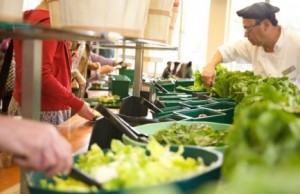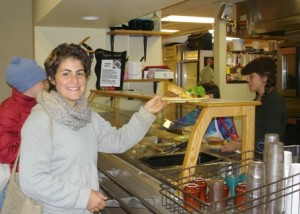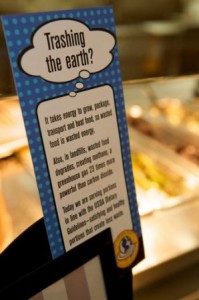We have much more to do and your continued support is needed now more than ever.
Climate-Savvy Menus: Eating Lower on the Food Chain

Energy-intensive animal proteins
North Americans love their meat, yet animal protein diets are a relatively new phenomenon. Meat production is now five times higher than it was in 1950, with the average person living in an industrialized nation consuming over 175 pounds of the stuff annually (three times higher than those in developing countries).
The problem isn’t so much the quantity that we eat, but the effects of such quantities from the industry as a whole. The confined animal feeding operations (CAFOs) of today actually generate 18 percent more greenhouse gas emissions (CO2 equivalent) than the transport sector. This is due in large measure to the direct addition of greenhouse gas emissions by the livestock sector, which contributes 65 percent of human-related nitrous oxide emissions and 30 percent of all human-caused methane emissions.
Then there’s deforestation, an environmental problem that accounts for 20 percent of carbon emissions due to human activities. Increased demand for meat increases demand for more land offshore, which ultimately drives the expansion of agricultural development in sensitive regions such as the Amazon rainforest. Eighty percent of the soybeans grown worldwide are fed to animals, and Greenpeace estimates that 23 million hectares in Brazil have been co-opted for soy production.
By contrast, a plant-based diet requires much less land. If all New Yorkers were to switch to a low-fat vegetarian diet, the state could directly support 50 percent more people than it does currently, a number equivalent to about 32% of the state’s entire population.
With climate impacts all along the meat food chain, it’s clear that our protein choices matter. And for many cafeteria diners, it’s getting easier to eat lower on the food chain.
Building sustainability into the menu

Warren Wilson College (WWC), a recent ACUPCC signatory, is in the process of launching its climate action plan, but thanks to an active student body, vegetarian food choices have been a big part of campus life since 1999. That was the year the Cowpie Café opened, following student demand for a vegetarian alternative to the conventional dining hall.
“We were just about to launch a hamburger-type café,” explains Margo Flood, chief sustainability official of the Environmental Leadership Center, “but students got involved with Sodexo [campus food provider] and indicated that they wanted something different.” The Cowpie’s popularity has spilled over into the regular dining hall, which now devotes 60% of its menu to vegetarian choices.
WWC’s sustainable food task force has been tracking local foods served and the emissions from food waste, and plans are in the works to begin to track the climate benefits of foods lower on the food chain in the 2009/10 year. “Sodexo has been tremendously supportive of our sustainable food initiatives,” says Flood. “They have incentivized our shift to green even though there have been some challenges to sourcing better food options.”

Working with over 400 cafes in 29 states, the food management company launched its Low Carbon Diet in 2007 as a way of giving customers the full carbon picture of their everyday food choices. “The Low Carbon Diet was designed to do two things–challenge chefs to make smarter editorial choices about the proteins they serve and raise awareness among students without eliminating their right to choose,” comments Helene York, director of the Bon Appétit Management Company Foundation.
Partnerships between students and Bon Appétit have been key to the success of the Low Carbon Diet. “Bon Appétit’s mission fits well with the culture on our campus,” says Chris Moody, executive director of Housing and Dining Programs at American University (AU).
A Bon Appétit customer since 2001, AU prides itself on its reputation for a socially-conscious and concerned student body.Vegetarian and vegan options are offered in all AU residential dining and retail facilities on campus. At the same time, management has had to be sensitive to all dietary preferences–food choice can be a sensitive issue. “There are some students who request more beef and cheese and so their requests are met, but most appreciate the lengths to which Bon Appétit will go to promote greener menu options.”
The Low Carbon Diet allows individual chefs to explore different methods for reducing the overall climate impact of their operations. Through reductions in meat and dairy ingredients, composting food waste, cutting air freight for seafood, limiting disposable packaging, and using more efficient equipment, each café contributes to the campaign’s overall greenhouse gas reduction goals.
In several cafes, signs indicating the relative climate impact of a hamburger compared to a vegetarian burger have been developed to raise awareness. Another popular approach is to create tempting veggie alternatives like vegetarian pho bowls, Anasazi bean burgers with shallots and Jerusalem artichokes, or roasted vegetable and pesto pizza.
Quantifying protein choices
One of the greatest challenges for this campaign has been quantification of the relative climate impact of various dietary choices. The dearth of research prompted Bon Appétit to do their own lifecycle analysis, the result of which was their Eat Low Carbon Diet Calculator.
The Low Carbon Diet campaign is a year-round effort, with at least one day dedicated to promoting low carbon food choices annually. The second year of this three-year drive is now complete and Bon Appétit has reduced their beef purchases by 33 percent, exceeding their goal of a 25 percent reduction.
Like Bon Appétit, UC-Berkeley has discovered that it can be challenging to track food purchases as part of an institutional sustainability plan, but they’re making an attempt anyway. Of the institution’s total carbon footprint of 460,000 tons annually, which includes non-inventory items in a broader lifecycle assessment, food purchases make up 5 percent or 13,000 tons.
“Since there are few protocols for this type of analysis it can be difficult to include food purchases in our calculations,” explains Lisa McNeilly, director for the Office of Sustainability. “But you don’t manage what you don’t measure, and we’re trying to measure the right things.”

Galarneau feels that it’s important to increase vegetarian options and couple that with student activism in support of sustainable food. According to Galarneau, some food service providers have tried to promote meatless days, but the students revolted.
Nevertheless, most institutions working on this issue seem to combine both approaches. The Real Food Challenge is a strong movement on the UCSC campus, but they also recently launched a Beefless Wednesdays initiative, which will be followed shortly by a new signage program explaining the carbon footprint of all menu offerings.
UC-Berkeley also supports the Real Food Challenge standards, while also working food choices into their greenhouse gas reduction plan. Today, 75 percent of all menu choices are vegetarian (70 percent are vegan). Their aim is to reduce carbon emissions to 1990 levels by 2014, which is six years faster than the state requires, and future climate plans may factor meat choices into their calculations.
Reducing meat and dairy only one piece of the puzzle
Regardless of approach, raising awareness about the environmental impacts of meat and dairy is another tool institutions can use to reduce their climate impact. It should not be claimed that eating lower on the food chain is the ultimate means to achieving carbon neutrality, but is part of a set of strategies for the universities using it. By combining enticing foods with solid education, most students are happy to make a difference with their food choices.




















